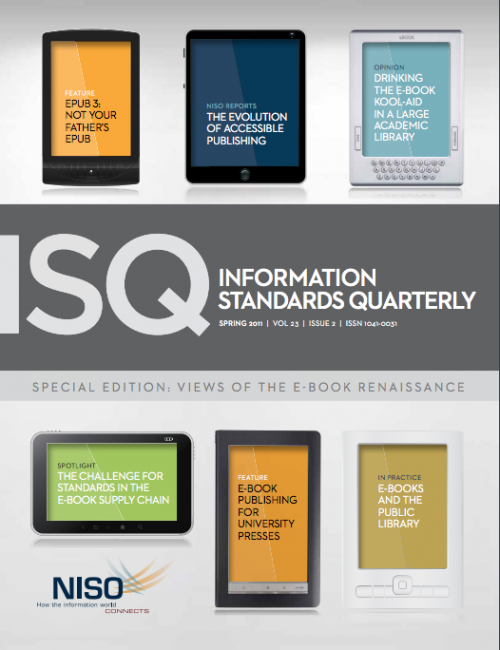Letter from the Editor
October Ivins, Principal and Consultant, Ivins eContent Solutions
NOTE TO READER: Download the PDF of this issue.
Views of the E-book Renaissance
Those of us who participated in the first round of e-book development (1998 to 2001) understand too well how the lack of standards hinders not only development and investment, but sales and usage. Our goal for this issue of ISQ is to present an overview of the status of e-books from multiple perspectives—publishers and other content producers, librarians, and the many vendors who support their creation, management, sales, and distribution. Not coincidentally, it also illustrates the scope of the NISO community.
The Open E-book Forum, an industry group focused on trade publishing, created the OEPS (Open e-book Publication Structure) in 1999 and continued to enhance and maintain it. In 2005, the OEB became the IDPF (International Digital Publishing Forum) to reflect interest in all types of digital publications and released the initial EPUB specification in 2007. Last year they welcomed collaboration with scholarly and academic publishers and vendors on EPUB 3.
The first feature article, by Bill Kasdorf, is a lively explanation of the process of adapting EPUB 2.0.1, a “flowable” format created to display fiction on multiple devices, to EPUB 3, a format that supports much of the scholarly apparatus required for academic publications. The new specification was approved by the Board in May after a comments period and is expected to become a final IDPF Recommended Specification later this summer. University press director Marlie Wasserman contributes a second feature, answering 10 ill-informed questions or assumptions about e-books that academic publishers must address to succeed as e-book producers.
The perspectives of both public and academic librarians are displayed in two submissions. Marcia Learned Au and Mollie Pharo present a cogent case study of a medium-sized public library that has built an e-book collection over 11 years. au and Pharo observe that their downloads from overdrive increased 500% from Jan. 2010 to Jan. 2011, and 800% in the last quarter of 2010 alone. Since PDFs are still the preferred format for academic books, and laptops and desktops the preferred devices for reading them, their experience provides valuable insights about device use and training, policy development, and more for public librarians. Wendy Shelburne contributes an entertaining opinion piece outlining her love/hate relationship with e-books as an academic librarian. The role for more and better standards is apparent in both of these contributions.
The standards spotlight is a gem. Mark Bide offers a clear overview of the various standards initiatives EDItEUR is developing, and how they interact with other standards. His descriptions of the challenges of standardizing e-book metadata makes the task seem even more difficult than one imagined. For the NISO member report, we invited EBSCO to report on their progress in revamping NetLibrary, a legacy e-book system in need of both technological and business model revision. Michael Gorrell explains EBSCO’s plans, and provides a timetable for their product redevelopment.
The first NISO report is an excellent description by Matt Garrish and Markus Gylling on the evolution of the DAISY standard to make e-books accessible for visually impaired users. The last article is a discussion by Todd Carpenter of the newly created NISO E-books Special Interest Group. E-book interest is not new for NISO, who with OCLC commissioned a valuable study in 2009 by Judy Luther, Streamlining E-book Metadata Workflow. We can look forward to the continued cooperation among standards groups that e-books will need to reach their full potential.
Streamlining e-book metadata Workflow: www.niso.org/publications/white_papers/StreamlineBookmetadataWorkflowWhitePaper.pdf
October Ivins, Principal and Consultant, Ivins eContent Solutions and ISQ Guest Content Editor

